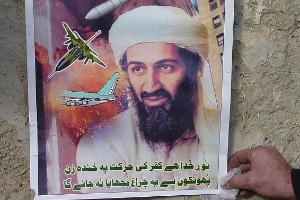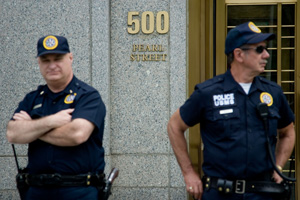Read Karen Greenberg’s previous coverage of the trial of Ahmed Khalfan Ghailani, the first Guantanamo detainee to be tried in a civilian court.
If Wednesday’s testimony was a step into the historical al Qaeda, now obsolete in many ways, yesterday’s was an attempt to link that al Qaeda back to the defendant. By the end of the day, Ghailani seemed slightly more present in the prosecution’s grand narrative.
The day began with a description of al Qaeda’s criteria for selecting new members. “Young and trust,” L’Houssaine Kherchtou, a former al Qaeda member and Osama bin Laden’s pilot, testified. Young because “if you are new, nobody knows who you are.” “Trust is very important,” he asserted several times.
Kherchtou was confident during his direct examination the other day, his memory full of granular detail, his words nearly matching those he had used at the first embassy bombing trial in 2001. His easy manner belied the violent nature of the organization he was describing. But on cross examination yesterday, he became a more elusive witness: “I don’t remember,” “What do you mean by missions?”, “What does ‘revered’ mean?”
Lead defense counsel Peter Quijano came to the podium armed with three notebooks, one of which—a white patent leather one—was so large as to warrant a position on the railing. But he was largely frustrated in his efforts to use Kherchtou to separate his client from the world of Al Qaeda presented by the prosecution. Quijano’s mostly futile attempt to push back against a witness who clearly knew the tactics of frustrating his interlocutor was not helped any by his continual stumbling over the names of the characters who made up Kherchtou’s narrative. At times, he said one name when he meant another; sometimes he merely mispronounced or misstated the names of alleged al Qaeda members and associates. Quijano tried to elicit details from Kherchtou about radical Islam—the growing of beards, the wearing of tunics, the swearing of bayat, an oath to Osama bin Laden—perhaps to prove at a later point that Ghailani did not participate in these customs. Quijano also attempted to contradict Kherchtou’s testimony, asking, for example, whether al Qaeda used the phones of those who were not part of a mission as a means of camouflage. Kherchtou said no.
Later in the day, the focus on Ghailani became more specific as the government tried to make the case for his involvement in procuring batteries and outfitting the truck used in the 1998 bombing of the US embassy in Tanzania, as well as his attempt to flee the country on the same flight as other members of the operation. Amid all this, Ghailani sat in the courtroom in white shirt and striped tie, still reserving his right not to appear on the grounds that the strip search required when he comes in and out of court triggers his torture-induced PTSD.
Now that the razzle-dazzle of this trial—the pretrial hearings on torture, the photographs and graphic witness testimony about the destruction of the bombing—is over, the sparring match can begin. But there is an unknown in this case: The jury’s general knowledge of al Qaeda and terrorism. Ten years ago, the first embassy bombings trial introduced many of the details of al Qaeda and bin Laden that have now become basic knowledge, even to those who are not experts. Some of this information has seeped into the popular culture in best-selling books such as Lawrence Wright’s The Looming Tower, movies such as David Ignatius’s Body of Lies, and even 24. Likely, this is a much savvier jury than the one that listened to the witnesses in the days before 9/11. They may be more comfortable than the defense counsel with the names and even the customs being described on the stand, and less tolerant than their predecessors of mistakes and sweeping generalizations about Muslims and al Qaeda.
All of which may mean that the Ghailani trial will, in the end, actually be seen as being about a terrible crime, rather than an unknown and mysteriously powerful enemy. In which case, this trial will have done what the judicial system is designed to do—teach the public that its institutions can address and examine acts of murder and devastation with evidence, narrative, and the judgment of men and women.
(Research for this article was contributed by Center on Law and Security researcher Paul Kleist, Jr.)










